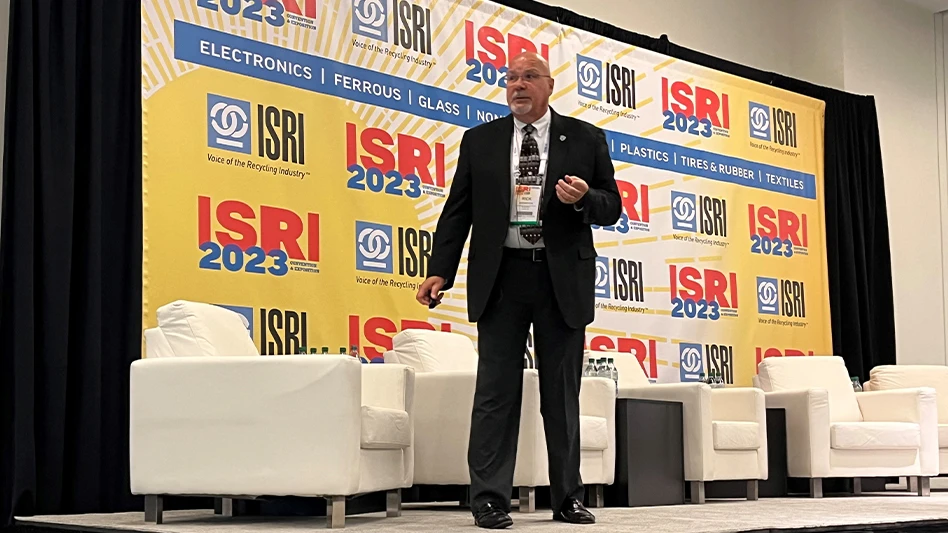
Photo by Chris Voloschuk
Scrap yard and recycling facility owners cannot guarantee total safety for the valuable products stored on their premises, but they can make it harder for thieves to access them.
According to Rick Arrington, a retired police officer of nearly three decades and founder, CEO and lead instructor at Hardy, Virginia-based Crime Prevention Center for Training and Services LLC, plant managers must attempt to “think like a crook” to protect their valuable commodities.
RELATED: ISRI2023: China opens door wider for nonferrous scrap
Arrington hosted the Crime Prevention Through Environmental Design session during the Institute of Scrap Recycling Industries (ISRI) 2023 Convention & Exposition in Nashville, Tennessee, and said securing facilities should be considered a top priority. “It requires consistent management because it’s a fluid process,” he said.
Arrington encouraged yard managers to look at risk factors, such as the likelihood of a particular crime happening at their facilities, how vulnerable a facility is to different types of crime and the impact if a theft were committed, necessitating the allocation of additional effort and resources to deter it in the future.
“[What types of security you deploy] at your facility depends on what you’re trying to protect,” he said. “You’re not going to spend maximum resources to protect something you’re only going to lose a certain amount of money for.”
Based on his vast law enforcement experience, Arrington said criminals typically select targets based on their sought-after reward, the availability of their target, their potential for success without being detected, available excuses if discovered and the difficulty of carrying out the act. For example, facilities that are poorly designed, abandoned or dimly lit can create an optimal environment for prospective thieves.
To make valuable material, such as steel, copper or catalytic converters, safer, facilities first must increase the effort required to steal it. Arrington suggested using “security in layers,” with the first layer of defense being a facility’s perimeter, keeping the most valuable assets as close to the middle of a facility as possible.
“If items must be stored outside, secure them in a fenced lot away from the perimeter,” he added.
Heavier gauge fencing with tight mesh, taught wire alarms that notify when the fence is cut and even barbed wire toppers could be theft deterrents. Arrington suggested adding boulders along the inside of the fence and planting thorny, “defensive vegetation” around the outside, while reinforcing vehicular gates with locks that cannot be cut, or creating a single point of entry and exit for a facility.
To reduce potential rewards for criminals, Arrington suggested keeping a minimal amount of frequently stolen items on-site or marking them to make it so police or other recyclers know where the product came from. He also advised against sharing with customers where items are stored in a facility.
Lighting also plays an important role in crime prevention. Having facility lighting that is observable by neighbors, passing vehicles or pedestrians is ideal.
“Get a motion-activated light and have that light shining upward,” Arrington said. “Then, let the police know you’ve installed it.”
Arrington also suggested forming a relationship with police, inviting officers to stop by the facility for a tour to “show them what a good facility looks like.”
Though he noted the average alarm response time by police is longer than 30 minutes, Arrington said audible alarm systems, as well as monitored video surveillance and prominent, well-placed signage, also can fill security gaps and remove excuses for thieves.
“Cameras are investigative tools unless they’re actively monitored; then they become preventative tools,” he said. “With alarms, I prefer a dual-audible and dialed-down alarm system—silent and audible. Audible will stop (thieves) dead in their tracks. … An audible alarm is more preventative.
“[With surveillance video], this is one of my favorite things to do: I always say to put up a sign, a big, bold sign, right above or below the camera, angled out, that says the premises are monitored,” he added. “I want it to be bright, because when people come in, the placement of the sign will force them to [turn toward it], and I’ll get a good shot, which is what I want. Whatever it takes to get them to look up into the camera. We’ve done that before [in my career] and were very successful.”
Facility managers also can take steps to thwart crime internally. Arrington said management should address employee theft or collusion with a zero-tolerance policy, making it clear that employees will be terminated if they’re caught stealing. He also suggested a clear separation of employee duties and limiting access to all parts of the facility.
“If you fix these holes, you’ll be surprised what your results will be,” he said.
ISRI2023 took place April 17-20 at the Music City Center in Nashville.
Latest from Recycling Today
- Orion ramping up Rocky Mountain Steel rail line
- Proposed bill would provide ‘regulatory clarity’ for chemical recycling
- Alberta Ag-Plastic pilot program continues, expands with renewed funding
- ReMA urges open intra-North American scrap trade
- Axium awarded by regional organization
- Update: China to introduce steel export quotas
- Thyssenkrupp idles capacity in Europe
- Phoenix Technologies closes Ohio rPET facility





